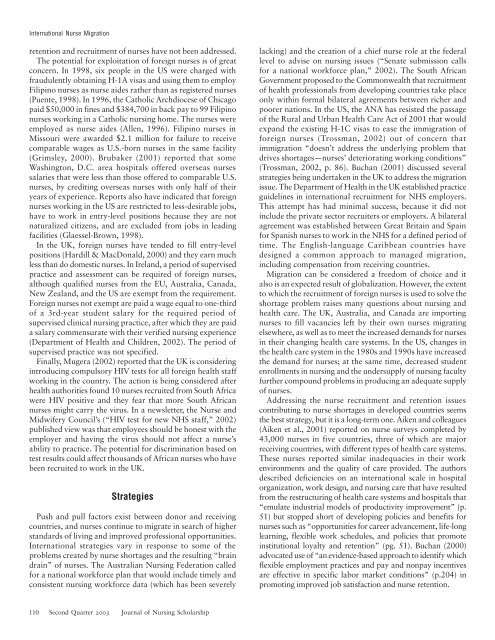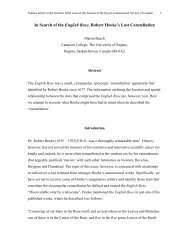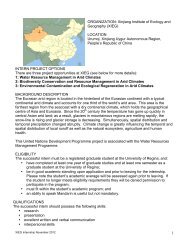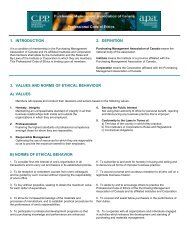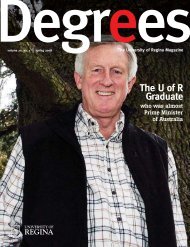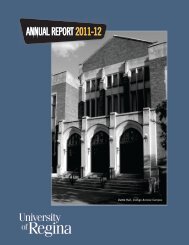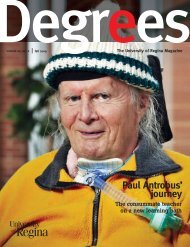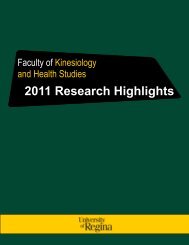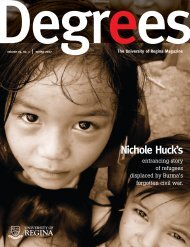Push and Pull Factors in International Nurse Migration - University of ...
Push and Pull Factors in International Nurse Migration - University of ...
Push and Pull Factors in International Nurse Migration - University of ...
You also want an ePaper? Increase the reach of your titles
YUMPU automatically turns print PDFs into web optimized ePapers that Google loves.
<strong>International</strong> <strong>Nurse</strong> <strong>Migration</strong>retention <strong>and</strong> recruitment <strong>of</strong> nurses have not been addressed.The potential for exploitation <strong>of</strong> foreign nurses is <strong>of</strong> greatconcern. In 1998, six people <strong>in</strong> the US were charged withfraudulently obta<strong>in</strong><strong>in</strong>g H-1A visas <strong>and</strong> us<strong>in</strong>g them to employFilip<strong>in</strong>o nurses as nurse aides rather than as registered nurses(Puente, 1998). In 1996, the Catholic Archdiocese <strong>of</strong> Chicagopaid $50,000 <strong>in</strong> f<strong>in</strong>es <strong>and</strong> $384,700 <strong>in</strong> back pay to 99 Filip<strong>in</strong>onurses work<strong>in</strong>g <strong>in</strong> a Catholic nurs<strong>in</strong>g home. The nurses wereemployed as nurse aides (Allen, 1996). Filip<strong>in</strong>o nurses <strong>in</strong>Missouri were awarded $2.1 million for failure to receivecomparable wages as U.S.-born nurses <strong>in</strong> the same facility(Grimsley, 2000). Brubaker (2001) reported that someWash<strong>in</strong>gton, D.C. area hospitals <strong>of</strong>fered overseas nursessalaries that were less than those <strong>of</strong>fered to comparable U.S.nurses, by credit<strong>in</strong>g overseas nurses with only half <strong>of</strong> theiryears <strong>of</strong> experience. Reports also have <strong>in</strong>dicated that foreignnurses work<strong>in</strong>g <strong>in</strong> the US are restricted to less-desirable jobs,have to work <strong>in</strong> entry-level positions because they are notnaturalized citizens, <strong>and</strong> are excluded from jobs <strong>in</strong> lead<strong>in</strong>gfacilities (Glaessel-Brown, 1998).In the UK, foreign nurses have tended to fill entry-levelpositions (Hardill & MacDonald, 2000) <strong>and</strong> they earn muchless than do domestic nurses. In Irel<strong>and</strong>, a period <strong>of</strong> supervisedpractice <strong>and</strong> assessment can be required <strong>of</strong> foreign nurses,although qualified nurses from the EU, Australia, Canada,New Zeal<strong>and</strong>, <strong>and</strong> the US are exempt from the requirement.Foreign nurses not exempt are paid a wage equal to one-third<strong>of</strong> a 3rd-year student salary for the required period <strong>of</strong>supervised cl<strong>in</strong>ical nurs<strong>in</strong>g practice, after which they are paida salary commensurate with their verified nurs<strong>in</strong>g experience(Department <strong>of</strong> Health <strong>and</strong> Children, 2002). The period <strong>of</strong>supervised practice was not specified.F<strong>in</strong>ally, Mugera (2002) reported that the UK is consider<strong>in</strong>g<strong>in</strong>troduc<strong>in</strong>g compulsory HIV tests for all foreign health staffwork<strong>in</strong>g <strong>in</strong> the country. The action is be<strong>in</strong>g considered afterhealth authorities found 10 nurses recruited from South Africawere HIV positive <strong>and</strong> they fear that more South Africannurses might carry the virus. In a newsletter, the <strong>Nurse</strong> <strong>and</strong>Midwifery Council’s (“HIV test for new NHS staff,” 2002)published view was that employees should be honest with theemployer <strong>and</strong> hav<strong>in</strong>g the virus should not affect a nurse’sability to practice. The potential for discrim<strong>in</strong>ation based ontest results could affect thous<strong>and</strong>s <strong>of</strong> African nurses who havebeen recruited to work <strong>in</strong> the UK.Strategies<strong>Push</strong> <strong>and</strong> pull factors exist between donor <strong>and</strong> receiv<strong>in</strong>gcountries, <strong>and</strong> nurses cont<strong>in</strong>ue to migrate <strong>in</strong> search <strong>of</strong> higherst<strong>and</strong>ards <strong>of</strong> liv<strong>in</strong>g <strong>and</strong> improved pr<strong>of</strong>essional opportunities.<strong>International</strong> strategies vary <strong>in</strong> response to some <strong>of</strong> theproblems created by nurse shortages <strong>and</strong> the result<strong>in</strong>g “bra<strong>in</strong>dra<strong>in</strong>” <strong>of</strong> nurses. The Australian Nurs<strong>in</strong>g Federation calledfor a national workforce plan that would <strong>in</strong>clude timely <strong>and</strong>consistent nurs<strong>in</strong>g workforce data (which has been severelylack<strong>in</strong>g) <strong>and</strong> the creation <strong>of</strong> a chief nurse role at the federallevel to advise on nurs<strong>in</strong>g issues (“Senate submission callsfor a national workforce plan,” 2002). The South AfricanGovernment proposed to the Commonwealth that recruitment<strong>of</strong> health pr<strong>of</strong>essionals from develop<strong>in</strong>g countries take placeonly with<strong>in</strong> formal bilateral agreements between richer <strong>and</strong>poorer nations. In the US, the ANA has resisted the passage<strong>of</strong> the Rural <strong>and</strong> Urban Health Care Act <strong>of</strong> 2001 that wouldexp<strong>and</strong> the exist<strong>in</strong>g H-1C visas to ease the immigration <strong>of</strong>foreign nurses (Trossman, 2002) out <strong>of</strong> concern thatimmigration “doesn’t address the underly<strong>in</strong>g problem thatdrives shortages—nurses’ deteriorat<strong>in</strong>g work<strong>in</strong>g conditions”(Trossman, 2002, p. 86). Buchan (2001) discussed severalstrategies be<strong>in</strong>g undertaken <strong>in</strong> the UK to address the migrationissue. The Department <strong>of</strong> Health <strong>in</strong> the UK established practiceguidel<strong>in</strong>es <strong>in</strong> <strong>in</strong>ternational recruitment for NHS employers.This attempt has had m<strong>in</strong>imal success, because it did not<strong>in</strong>clude the private sector recruiters or employers. A bilateralagreement was established between Great Brita<strong>in</strong> <strong>and</strong> Spa<strong>in</strong>for Spanish nurses to work <strong>in</strong> the NHS for a def<strong>in</strong>ed period <strong>of</strong>time. The English-language Caribbean countries havedesigned a common approach to managed migration,<strong>in</strong>clud<strong>in</strong>g compensation from receiv<strong>in</strong>g countries.<strong>Migration</strong> can be considered a freedom <strong>of</strong> choice <strong>and</strong> italso is an expected result <strong>of</strong> globalization. However, the extentto which the recruitment <strong>of</strong> foreign nurses is used to solve theshortage problem raises many questions about nurs<strong>in</strong>g <strong>and</strong>health care. The UK, Australia, <strong>and</strong> Canada are import<strong>in</strong>gnurses to fill vacancies left by their own nurses migrat<strong>in</strong>gelsewhere, as well as to meet the <strong>in</strong>creased dem<strong>and</strong>s for nurses<strong>in</strong> their chang<strong>in</strong>g health care systems. In the US, changes <strong>in</strong>the health care system <strong>in</strong> the 1980s <strong>and</strong> 1990s have <strong>in</strong>creasedthe dem<strong>and</strong> for nurses; at the same time, decreased studentenrollments <strong>in</strong> nurs<strong>in</strong>g <strong>and</strong> the undersupply <strong>of</strong> nurs<strong>in</strong>g facultyfurther compound problems <strong>in</strong> produc<strong>in</strong>g an adequate supply<strong>of</strong> nurses.Address<strong>in</strong>g the nurse recruitment <strong>and</strong> retention issuescontribut<strong>in</strong>g to nurse shortages <strong>in</strong> developed countries seemsthe best strategy, but it is a long-term one. Aiken <strong>and</strong> colleagues(Aiken et al., 2001) reported on nurse surveys completed by43,000 nurses <strong>in</strong> five countries, three <strong>of</strong> which are majorreceiv<strong>in</strong>g countries, with different types <strong>of</strong> health care systems.These nurses reported similar <strong>in</strong>adequacies <strong>in</strong> their workenvironments <strong>and</strong> the quality <strong>of</strong> care provided. The authorsdescribed deficiencies on an <strong>in</strong>ternational scale <strong>in</strong> hospitalorganization, work design, <strong>and</strong> nurs<strong>in</strong>g care that have resultedfrom the restructur<strong>in</strong>g <strong>of</strong> health care systems <strong>and</strong> hospitals that“emulate <strong>in</strong>dustrial models <strong>of</strong> productivity improvement” (p.51) but stopped short <strong>of</strong> develop<strong>in</strong>g policies <strong>and</strong> benefits fornurses such as “opportunities for career advancement, life-longlearn<strong>in</strong>g, flexible work schedules, <strong>and</strong> policies that promote<strong>in</strong>stitutional loyalty <strong>and</strong> retention” (pg. 51). Buchan (2000)advocated use <strong>of</strong> “an evidence-based approach to identify whichflexible employment practices <strong>and</strong> pay <strong>and</strong> nonpay <strong>in</strong>centivesare effective <strong>in</strong> specific labor market conditions” (p.204) <strong>in</strong>promot<strong>in</strong>g improved job satisfaction <strong>and</strong> nurse retention.110 Second Quarter 2003 Journal <strong>of</strong> Nurs<strong>in</strong>g Scholarship


